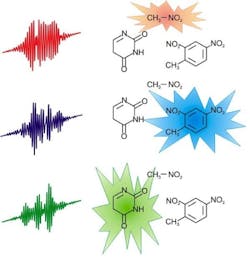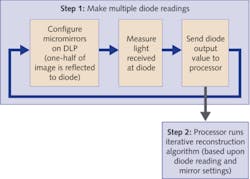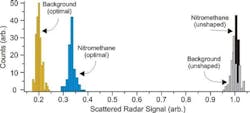SPECTROSCOPY: Optimal Dynamic Detection enhances sensitivity of explosives detection
SHAWN D. McGRANE, MARGO. T. GREENFIELD, JASON SCHARFF, DAVID S. MOORE, JONATHAN ROSLUND, and HERSCHEL RABITZ
Explosives pervade most violent threats that the world faces today. Explosive materials are essential components of improvised explosive devices, suicide bombs, package bombs, and the means for dispersing chemical, biological, or radiological compounds in dirty bombs. The first step toward neutralizing these threats is identification. For safety, it is desirable to be able to detect and identify explosives at large standoff distances; 50 m is a common goal. Unfortunately, many explosives have very low vapor pressures, making the detection of molecules in the air exceedingly difficult.1 One must then look for microscopic trace contamination that may have been left on an external surface—another challenging prospect.
While a number of analytical methods can detect and identify explosives, the number of plausible techniques operable at realistic standoff distances is few.2 Some of the most promising techniques rely on laser excitation (such as standoff Raman spectroscopy, laser-induced breakdown spectroscopy, and laser-induced fluorescence). And even though there are numerous incremental improvements that can be made to current laser-based standoff methods, the desired capabilities demand a revolutionary shift to higher levels of sensitivity and selectivity. Optimal Dynamic Detection of Explosives (ODD-Ex) is a novel framework for developing solutions to these seemingly impossible problems.
ODD-Ex and femtosecond pulse shaping
The essential ingredient of ODD-Ex is adaption of the interrogating laser to the quantum molecular dynamics of the target explosive. For any given laser/molecule nonlinear interaction leading to a signal, such as light emission or ionization, a pulse exists that will optimize that signal.3 This pulse is typically not what comes out of a commercial laser, but rather must be adapted to suit the specific molecule and spectroscopic signature of interest (see Fig. 1).
There is a strong theoretical foundation underlying both the existence of the optimal control field and a feature of the control search landscape suggesting that the optimal solution can be readily discovered.4 With hundreds of possible molecules to detect, a laser that can emit hundreds of different pulse types is likewise necessary. Since the laser seeks to control the action of the molecules on their natural vibrational, rotational, and electronic timescales, a short-pulse femtosecond laser is required. Although commercial lasers are not yet available with the appropriate pre-programmed pulses, the technology already exists to shape femtosecond pulses into complex, time-dependent optical fields. Chemists and physicists have been developing techniques to control molecular dynamics with shaped pulses for decades, and the techniques have come to a maturation level sufficient to attack applied problems such as explosives detection.
The technological basis of quantum control with femtosecond laser pulses relies on placing a programmable phase and amplitude mask in the Fourier plane of a zero dispersion stretcher (see Fig. 2).5, 6 Essentially, this is just two back-to-back spectrometers with the mask placed at the central focal plane. At the mask, the colors are spatially separated and each spectral component interacts with separate pixels of a spatial light modulator. Each spectral component then has a computer-controlled phase and amplitude added to it. When the pulse is spectrally and temporally reconstructed through the second spectrometer, the addition of spectral phase or modulation of amplitude reshapes the initially short, simple pulse into a richer, more diverse temporal waveform. This process provides a versatile computer-controlled, time-dependent electric field that can be arbitrarily shaped to control the interaction of the field with molecules, thereby manipulating the molecular dynamics.Developing ODD-Ex
The next step becomes how best to apply this pulse-shaping technology to the challenge of explosives detection. Herschel Rabitz’s research group at Princeton University (Princeton, NJ) has pioneered the theoretical foundations of quantum control and has in recent years grown an extensive experimental program as well. The team led by David Moore at Los Alamos National Laboratories (LANL; Los Alamos, NM) has been applying femtosecond spectroscopies to explosive materials for more than a decade and has developed an extensive effort in applying quantum control to explosives detection. The collaboration between the two groups was spurred by the needs of the U.S. Department of Homeland Security for dramatically better next-generation explosives detection technologies. A new paradigm for addressing the problem of explosive detection is essential, and ODD-Ex offers a radically different approach.
ODD-Ex combines the ability to shape femtosecond optical pulses with advanced machine-learning algorithms to quickly determine the pulse shape that optimizes a unique signature for a specific molecule or molecular fragment. The concept of using an experimental feedback loop to determine the pulse shape was first proposed by Judson and Rabitz and is now common practice in a range of applications.7, 8 For explosives detection, the idea is to first assemble a library of optimal pulse shapes for different types of explosives. This library of shapes may then be scanned at rates up to 1 kHz to rapidly identify any potentially threatening materials. These pulse shapes must be robust to different background materials that may also be present and overwhelm the signal originating from the target explosive.
One of the primary advantages of ODD-Ex over conventional laser-based detection methods is its ability to shape the pulse in such a way that the laser will not excite interfering materials. Another advantage is the capacity to utilize time-dependent molecular dynamics for discrimination amongst very similar molecules.9 The implementation can be performed using a number of different types of spectroscopy.
The Los Alamos team has focused on applying the ODD-Ex paradigm to coherent anti-Stokes Raman spectroscopy (CARS). The rationale for choosing CARS is that it is a nonlinear form of Raman spectroscopy that has already proven to be a very good method for detecting and identifying explosive materials. Hence, ODD-Ex is supplementing an already existing laser-based spectroscopy technique to make it even better. The large signals and beam directivity inherent to CARS avoid the problem of fluorescence interference that typically plagues ordinary Raman measurements of colored materials. Experiments of other groups also suggest that femtosecond pulse shaping implementations of CARS show significant promise.10, 11 Using the framework of ODD-Ex to find pulse shapes that optimize CARS signals, the Los Alamos team has shown that the explosive signal can be maintained while reducing the signal from interfering materials present by several orders of magnitude (see Fig. 3).12 Significant improvements in selectivity can be achieved in this manner, and the team expects even broader application will be possible with the next generation of studies currently underway.The future of pulse shaping
There are a number of scientific problems yet to be solved in order to successfully deploy pulse-shaping methodologies for explosive detection, and multiple research groups around the world are working to address them. Continued work is needed to better understand and predict the interactions between shaped laser pulses and complex molecular species. High fidelity control relies upon improvements in laser source spectral bandwidth, pulse-to-pulse stability, and the ability to deliver properly shaped pulses at a distance through turbulent and dusty air. In addition, ease of implementation necessitates continued development of laser sources that provide these characteristics in small, energy-efficient, robust, and inexpensive packages. Ideally, high-power femtosecond shaped-pulse fiber lasers could be applied in an assortment of environments at a variety of wavelengths. If the rate of advances in scientific understanding and ultrafast laser sources continue at the present pace, these seemingly idealistic dreams may be realized in the not-too-distant future.
REFERENCES
1. D.S. Moore, Sensing and Imaging, 8, 9-38 (2007).
2. D.S. Moore, Rev. Scient.Inst., 75, 2499-2512 (2004).
3. R. Chakrabarti and H. Rabitz, Intl Rev. in Physical Chem., 26, 671-735 (2007).
4. H. Rabitz, J. Modern Opt., 51, 2469-2475 (2004).
5. A.M. Weiner, Rev. Scient. Inst., 71, 1929-1960 (2000).
6. M.A. Dugan et al., J. OSA B, 14, 2348-2358 (1997).
7. R.S. Judson and H. Rabitz, Phys. Rev. Lett., 68, 1500-1503 (1992).
8. P. Nuernberger et al., Physical Chem. Chemical Phys., 9, 2470-2497 (2007).
9. M. Roth et al., Physical Rev. Lett., 102, 253001 (2009).
10. O. Katz et al., Appl. Phys. Lett., 92, 171116-171111-171113 (2008).
11. H. Li et al., Opt. Expr., 16, 5499-5504 (2008).
12. S.D. McGrane et al., New J. Phys., 11; doi: 10.1088/1367-2630/11/10/105047 (2009).
Shawn D. McGrane, Margo T. Greenfield, Jason Scharff, and David S. Moore are scientists at Los Alamos National Laboratory, MS P952, Los Alamos, NM 87545; e-mail: [email protected]; www.lanl.gov. Jonathan Roslund is postdoctoral research associate and Herschel Rabitz is professor of chemistry at Princeton University, Princeton, NJ 08544; www.princeton.edu.



